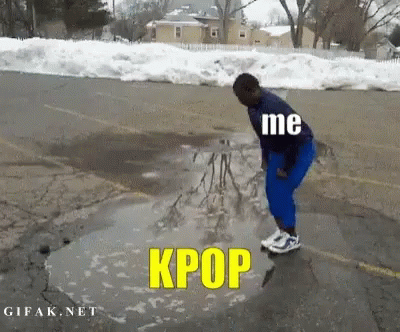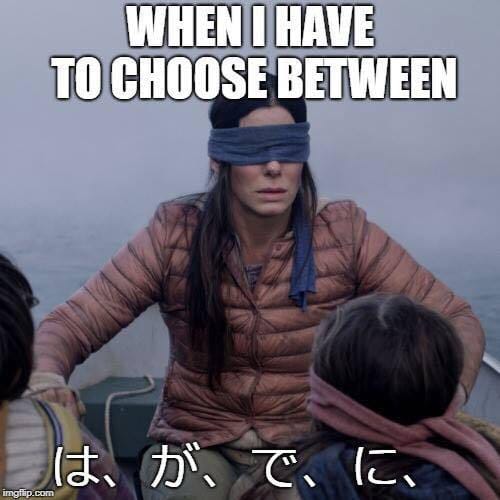Which Is Easier To Learn Japanese Or Korean
Ane does not only put "like shooting fish in a barrel" and "Kanji" in the same sentence.
Like the majority of people attracted to Japan's culture, I grew up with manga and anime. At that time dorsum in 2006, Korean or Japanese weren't really pop languages. Chinese, on the other hand, was marketed as THE linguistic communication of opportunity. Many high schools in French republic, including mine, offered it as an "extra-foreign" language.
Considering I was in a weeaboo denial stage, convincing myself that I liked "Asian culture in general" and not just the Japanese i, I chose to study Chinese for my whole three years of loftier schoolhouse in the hopes that it would gear up me for my ultimate weeb goal: study Japanese at university—which I did next.
Everything was going fine until a third chemical element joined the group: the Hallyu or Korean civilisation wave which spread M-popular, One thousand-dazzler, and K-drama all over the world. My weeaboo-ism, combined with the stress of learning Japanese "the hard style" (aka y'all must score 100% on all exams otherwise the rest of your life is pretty much doomed), mutated into a koreaboo-ism because of information technology.

I was stuck between my Japanese major (or at least the end of it), barely keeping up with three years of Chinese report and then that I could brand something of my life AND indulging myself completely in shiny new Chiliad-civilisation. My genius solution? Study Korean, Chinese, and Japanese at the same time. They've got to be pretty similar, right?
As it turns out. Aye and no. Luckily I fabricated information technology out of that linguistic black pigsty with a few ideas on which one is easiest that I'chiliad going to share with you.
Let the battle begin!
Round Ane: Reading

Kanji, Hanja, and Hanzi. No, these are not the names of The Iii Musketeers translated into Japanese but the labels for logograms—characters that symbolize a phrase or word—respectively in Japanese, Korean and Chinese.
Hanzi is the derivative Chinese term for Kanji and Hanja. It literally ways the characters of the "Han," the almost powerful indigenous grouping at the time when China began to export its culture beyond its borders. The Hanzi is a collection of more than vii,000 characters you'll use for everything (if y'all exclude the variations and ancient forms written in old books that make the total number over 100,000 characters). You have to learn each of the 7,000 characters one by i to exist able to navigate the Chinese world efficiently.
On the other side of the bounding main, there are 2,136 normally used Kanji characters in the Japanese language, called the Joyo kanji which are derived from Chinese Hanzi. Forth with those are the kana, characters for vocal syllables that include 46 hiragana, likewise derived from Chinese characters but KonMaried to their most minimalistic forms, and 46 katakana (which are mostly there just to make foreigners cringe).
Each Kanji also have two different readings: the ON-yomi, from Chinese origin, and the KUN-yomi, purely from Japanese origin. An easy style to know when you should use which is to recollect that KUN readings are normally used when the word is alone or combined with kana. The ON reading is only used when kanji are combined together.
That said ON and KUN are not express to only one reading. For example, a elementary kanji similar "上 ", meaning higher up, can take three ON readings (jo, sho, and shan) and vi KUN readings (ue, uwa, kami, noboru, agaru, tatematsuru). Yup.
Considering of these 3 "alphabet" systems, you lot can get away with learning only some of the Joyo kanji plus kana and yet exist able to empathize what you read without going back and forth on your dictionary.
Korean has 24 letters, namely Hanguls, with 14 consonants and 10 vowels. That'southward it! The Hanja are not used every bit much as earlier nor taught in school anymore. You'll observe Hanja only for abridgement or for stylistic reasons (to salve space for case), or in specific professions such as law or medicine.
On top of that, the written organisation has spaces. You can, therefore, await upwardly a word more easily than in Japanese or Chinese where in most cases you don't know where the give-and-take ends or begins, or even how to spell information technology.
Verdict: Korean is the easiest to read
Circular Two: Writing
There is a popular conventionalities that Chinese is the origin of both the Japanese and Korean languages. While information technology's true that aboriginal Korean and Japanese texts were solely written in classical Chinese, and Chinese characters were only studied past the elite of both countries for ages, they were actually read in the linguistic communication of each country following the same grammatical rules nosotros know today.
The electric current writing systems were only created later, for the common people, or to stand up out from Chinese written books. So, Japanese and Korean populations created their own reading and writing systems completely separate from the Chinese one.
The first thing you lot learn when you study Chinese is how to write the characters. And I'm not but talking almost the stroke orders. When I was studying in school information technology seemed to me that calligraphy was a huge part of the linguistic communication as my teacher spent so much time and endeavor to teach us about the radicals (a setlist of graphical elements that compose a Hanzi), their meaning, how each stroke is traced and virtually importantly where your pen should begin and end.
The radicals are actually similar in Japanese, and so if you're learning Japanese and want to report Chinese instead, in that location shouldn't be much confusion between the 2. You lot still have the kana on top of the Kanji, information technology just involves a piddling bit more than memorization. I hateful, at this point, learning 46 more characters is not going to kill you.
Even so, since Korean is the easiest language to read due to its letter-based reading system, that also means Korean is the easiest language to write. You still demand to know the grammar, though. Soz.
Verdict: Korean is the easiest to write
Round Iii: Speaking
Chinese, or Mandarin Chinese, has 25 consonants, 22 vowels and 19 diphthongs (a combination of two sounds within the aforementioned syllable) that overlap iv distinct tones. Fortunately, you'll be helped by the pinyin, the official romanization of Chinese characters for your pronunciation and tones like this: mā, má, mǎ, mà.
Still, that is A LOT of sounds for your oral cavity to recall and pronounce correctly to brand yourself understandable.
Notation also that Cathay has 56 distinct ethnic groups and more than 200 dialects within its massive borders which include Uighurs, Tibetans, Mongols, and Koreans. So it is very, very, very likely that you lot volition encounter regional specificities.
For Japanese, if you were told that information technology doesn't have intonation similar Chinese, y'all were lied to. Well-nigh every Japanese word has its own 発音 or intonation, when alone, and a dissimilar one when put together with other words. The rule is pretty piece of cake to understand once you get it, only you yet have to remember the "tones" for every other discussion.
It's good to bear in heed that the way you pronounce Japanese words won't really bear upon your advice ability to the same extent that Chinese does. In Japanese, every audio is pure without whatsoever alteration based on surrounding "letters." Exceptions though are things like 新橋 which becomes shithoubashi when said aloud.
And what about Korean? Well, information technology's non as difficult as Chinese, but you will definitely feel more than natural language twisters than in Japanese.
Different Japanese, Korean does have the "L" audio, ㄹ, but it can often come at the end of a word. It's like starting a archetype "50" merely stopping your tongue just before yous can hear the vowel that follows. There is also something chosen double consonants ㄲ (kk), ㄸ(dd), ㅃ(bb), ㅆ(ss), and ㅉ(jj) which are harder versions of their single counterparts.
In practice, it goes similar this: You're at a local market and you lot want to buy pants. Let's take 사다 which means "to buy" and 싸다 which means "to poop." If y'all're not being careful with your pronunciation you might end upwards maxim "I want to poop my pants," instead of "I want to buy these pants."
If y'all're not existence careful with your pronunciation y'all might end up saying "I desire to poop my pants," instead of "I desire to buy these pants."
Verdict: Japanese is the easiest to speak
Round 4: Listening

Chinese is hard to speak because of its many sounds combined with its four tones. The other way around is also true. Listening to Chinese is hard and when the tones are nonexistent like in songs, it's almost impossible to understand what the person means unless y'all read the lyrics—if you can read Chinese well plenty!
Japanese is comparably more understandable when listening mainly due to its total xiv bones consonants (thou, due south, t, n, h, m, y, r, w, k, z, d, b, and p) and 5 vowels (a, i, u, eastward and o).
Perhaps the but trouble yous'll encounter in Japanese volition be with words using "ん", northward, or the long "う", u sound. For case, 禁煙 , "non-smoking" and 近年 , "recently" or the distinction between a "infirmary,"病院 and a "hair salon,"美容院 .
Following the previous point about speaking, y'all will find many diphthongs, homophones and subtle sounds in the Korean language. The key is to get used to those new sounds, and I must acknowledge One thousand-dramas and Grand-pop music was a big aid for me but I withal have difficulties producing 송 , 승 and 성 .
The 4 tones of Chinese are crucial for listening to the language calculation a level of difficulty on superlative of the new sounds. With many vowels existence close to each other in the Korean linguistic communication, the pure syllabic sounds of the Japanese language means it wins this round. Is it time to caput over to your nearest karaoke to do? Aye!
Verdict: Japanese is easiest to mind to
Round Five: Grammar

The Chinese grammar system is very similar to Western languages every bit it's built around a bailiwick + verb + object structure. And guess what? No conjunctions! The past tense is only one character, 了 . If you lot already have a time indicator word, like 昨天 or "yesterday," you don't even demand 了 . #dealwithit
The Chinese grammer system is very like to Western languages as it'due south congenital around a subject + verb + object structure.
In that location is a dissimilar counter for different objects, but you don't have particles to indicate the subject or the management like in Japanese or Korean. Such particle concepts can be very confusing for foreigners as there's aught similar in most Romance and Germanic languages.
In Japanese, depending on which particles you lot choose, the word preceding it will have various meanings and functions. 海が , 海を or 海に uses the word 海 , the body of water, only が will point the subject of the action, を will be for the object or the action and に will be the location or the management of an activity.
That said, if you lot already know some grammar in one linguistic communication, learning the others should come more smoothly. For me, grammer books in English language for the Korean linguistic communication similar Talk to Me in Korean were OK, just I establish that Korean learning books in Japanese were much more effective for re-learning grammar concepts I'd already grasped in Japanese.
Concerning the verb conjugation, Japanese and Korean both have honorific differences and stems when conjugating verbs, but I establish the latter much more difficult every bit conjugation rules are influenced by how the discussion is written.
For case, in Korean, 마시다 is the dictionary form of "to beverage," but similar 飲む in Japanese. Where in Japanese you lot can apply the lexicon form as it is similar 水を飲む ("[I] drink water"), you tin't in Korean. You have to conjugate it.
In the example 마시다 , the last letter of the stem 마시 is the vowel "i" and then y'all need to add 어 . This is optional here but y'all tin as well add 요 , the polite particle. There is a vowel wrinkle when y'all attempt to put 시 , and 어 together, resulting in the final verb looking like this:마셔요 . Congratulations, you just conjugated the verb "to drink" in the declarative present polite form!
The same thing happens with most particles such as 을 /를 , and the を particle in Japanese (the object particle). In the example, "I drink water,"물 is water. 을 is used only when the word before ends with a consonant and 를 when the give-and-take ends with a vowel. The last letter of 물 is ㄹ (l), a consonant, therefore y'all'll use 을 . The final sentence is 물을 마셔요 .
It's pretty hard at the offset to remember outset nearly how the word is written to be able to put together a sentence or conjugate a verb, but it volition come up naturally with enough of practise.
Korean tenses include the future tense, which is not the case for Japanese. They both have unlike levels of politeness in the verb conjugation, which is absent-minded from the Chinese language.
The familiar grammer structure Chinese has makes information technology easier for united states of america Indo-European language-speakers to empathize.
A win for Chinese in the final circular!
Verdict: Chinese has the easiest grammer
The upshot?

I regret naught.
Chinese introduced me to ane of the most difficult aspects of Asian languages: Kanji characters, their writing, composition, and meaning. Learning this pretty early on gave me a skilful caput start when I began my Japanese major. On the other manus, studying Japanese helped me a lot with getting a chore in Japan and with learning Korean grammer.
Which is the easiest to learn IMO? It actually depends on the item skill you're tackling and what you personally find stimulating to acquire.
I can definitely say that there are real benefits to learning Chinese, Japanese and Korean (at the same time, or separately!) and that the languages complement each other really well. So if y'all're stuck deciding between them, know that you're not actually limited to just one throughout the course of your learning.

Of course, here at GaijinPot, we specialize in studying Japanese right here in Japan. You can explore more below:
- Learn Japanese with our original report materials on GaijinPot Study
- Questions nearly studying Japanese in Japan? Take a look at the Japan 101 section on Higher Education and Studying Japanese
- Join our GaijinPot Study Facebook group to connect with boyfriend learners
- Larn more about the GaijinPot Study Placement Program
Source: https://blog.gaijinpot.com/japanese-korean-chinese-which-language-is-the-easiest-to-learn/
Posted by: gibsonyessund.blogspot.com


0 Response to "Which Is Easier To Learn Japanese Or Korean"
Post a Comment